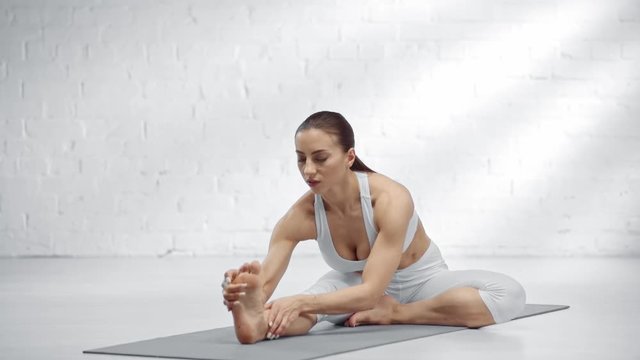Maha Mudra, literally translating to the “Great Seal,” is one of the most powerful and revered practices in classical Hatha Yoga. It is described in key yogic texts such as the Hatha Yoga Pradipika and the Gheranda Samhita as a technique capable of eradicating disease, balancing energy, and unlocking deep meditative states.
Table of Contents
How to Practice Maha Mudra?
Practice on an empty stomach (at least 3–4 hours after a meal). Choose a quiet, clean space. Perform a few minutes of warm-up stretches for the spine and hamstrings
Step 1:
Sit in Dandasana (legs stretched forward). Bend the left knee, placing the heel against the perineum. Keep the right leg extended, with toes pointing up.
Step 2:
Keep the spine straight. Hold the right big toe with both hands (use a strap if needed)
Step 3:
Inhale deeply. On exhale, perform Jalandhara Bandha (chin lock). Simultaneously apply Mula Bandha (pelvic floor contraction). Optionally, perform Shambhavi Mudra (gaze at the third eye)
Step 4:
Retain the breath comfortably. Focus on the spine, third eye, or breath energy. Hold until you feel the need to exhale (without strain).
Step 5:
Exhale gently. Release bandhas and chin lock. Straighten the left leg, bend the right leg. Repeat the same process on the other side
Recommended Duration:
- Start with 30 seconds per side
- Gradually increase to 2–3 minutes
- Practice 2–3 rounds on each side for balanced benefits
Benefits of Maha Mudra:
Here is a detailed overview of the benefits of Maha Mudra (The Great Seal) one of the most powerful yogic practices that integrates asana, pranayama, bandhas, and mudras. Practiced regularly, Maha Mudra offers benefits across the physical, mental, energetic, and spiritual planes.
- Activates the abdominal organs through breath retention and bandhas
- Helps alleviate constipation, bloating, and sluggish digestion
- Improves appetite and metabolic balance
- Tones pelvic floor muscles (via Mula Bandha)
- Strengthens spinal muscles, legs, and core
- Improves posture and relieves spinal stiffness
- Breath control and spinal alignment stimulate the parasympathetic nervous system
- Promotes relaxation, reduces stress, and improves neurological resilience
- Calms the mind by focusing on breath and inner stillness
- Sharpens concentration and mental focus
- Improves memory, insight, and decision-making
- Activates the vagal nerve and lowers cortisol
- Leads to a state of deep calm, helping with insomnia and restlessness
- The combination of mudra, breath, and bandhas helps manage emotional fluctuations
- Encourages inner balance, patience, and emotional maturity
- Balances ida (moon energy) and pingala (sun energy) nadis
- Activates the sushumna nadi, the central energy channel
- Prevents energy loss through Mula Bandha
- Directs prana upward through the spine, enhancing vitality
Precautions and Contraindications:
- Avoid if you have: Pregnancy, High blood pressure, Glaucoma or eye conditions, Heart disease, Spinal injuries, or severe back pain
- Don’t force the breath retention
- Don’t practice on a full stomach
- Always learn bandhas and kumbhaka under expert guidance
- If you feel dizzy or uncomfortable, stop and rest
Conclusion:
Maha Mudra is not just a technique, it is a spiritual sadhana. It is both subtle and powerful, balancing the pranic currents and drawing consciousness inward. Practiced with consistency, awareness, and devotion, Maha Mudra becomes a gateway to deep healing, spiritual awakening, and inner freedom.
FAQ:
Q. What does Maha Mudra mean?
A. “Maha” means great, and “Mudra” means seal or gesture. It is called the Great Seal because it seals the energy within the body and unites body, mind, and spirit.
Q. Is Maha Mudra safe for beginners?
A. It is best suited for intermediate practitioners. Beginners can try simplified versions without breath retention or bandhas until they are trained.
Q. What should I feel during the practice?
A. You may feel:
- A deep sense of stillness
- Subtle energy moving up the spine
- Enhanced concentration and inner silence
Q. When should Maha Mudra be practiced?
- Morning is ideal
- After asana but before meditation
- Never immediately after eating
Q. How is Maha Mudra linked to Kundalini awakening?
A. By harmonizing the ida, pingala, and sushumna nadis, Maha Mudra prepares the subtle body for the safe awakening of kundalini energy.
Q. Can I combine Maha Mudra with other practices?
A. Yes. It pairs well with:
- Nadi Shodhana
- Ujjayi pranayama
- Meditation
But combine only once you’re confident in the technique.
Q. How often should I practice Maha Mudra?
A. Start with 2–3 times per week, and gradually move to daily practice once comfortable.





